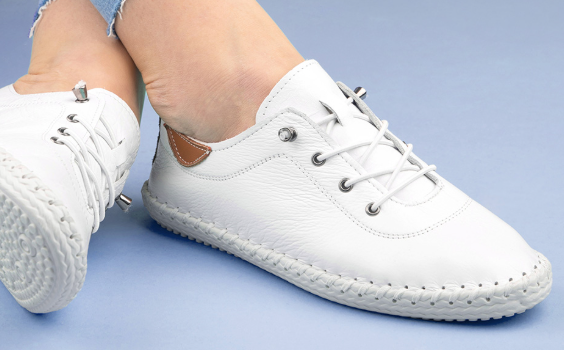
We’ve all been there – you’ve found the perfect pair of shoes, but they’re just a little too stiff or tight. Breaking in shoes doesn’t have to be a painful process. With a few simple tips, you can get your new footwear feeling as comfortable as it looks. Whether you’re dealing with leather boots or stylish sneakers, this guide will show you how to break in shoes without the discomfort.
Make Sure You’ve Got the Right Size
Before attempting to break in your new shoes, it’s crucial to ensure they’re the right size. A good fit is the foundation of comfort, and no amount of tricks will make a shoe feel right if it’s the wrong size.
- Measure your feet in the afternoon, when they are at their largest, as feet tend to swell throughout the day.
- Try both shoes. Your left and right feet can differ slightly in size, so it’s important to try on both to get an accurate fit.
- If you feel discomfort when trying on shoes, they may not be the right fit for you.
Wear Shoes Indoors with Socks
While it’s tempting to take your new shoes for a spin right away, it’s best to wear them around the house first. Add socks to create a bit more snugness, which helps to stretch out the shoes and prevent blisters. For a quicker stretch, opt for thicker socks to create gentle pressure that helps loosen tight spots faster.
Stretch Tight Areas with Shoe Stretchers or Socks
If you find specific areas of your shoes uncomfortably tight, a shoe stretcher can help. Simply insert a stretcher into your shoes overnight to gradually loosen tight spots. Alternatively, stuff your shoes with rolled-up socks and leave them overnight. This trick works wonders for shoes that are just a bit too snug.
Soften Leather Shoes with Leather Conditioner
New leather shoes can often feel stiff, but a bit of leather conditioner can make a significant difference. Apply a small amount to the problem areas using a soft cloth, and focus on spots that dig into your skin. Let the conditioner dry overnight, and your leather shoes will become more flexible and comfortable.
Gradually Adjust Sandal Straps
For new sandals, especially strappy ones, take it slow. Tight straps can cause discomfort and blisters, so loosen them at first. Wear the sandals for short periods at home to gradually adjust the straps for a more comfortable fit over time.
Take It Slow with Sneakers
Sneakers may look ready for action, but jumping into a long walk right after purchasing them might cause discomfort. Start by wearing your new sneakers for shorter periods, such as running errands or quick walks. Gradually increase the time you wear them as your feet become accustomed to the fit.
Use Heat and Thick Socks to Loosen Tight Shoes
For shoes that are still a bit too tight, you can use heat to help stretch them. Put on your thickest socks and aim a hair dryer at the tight spots while flexing your feet. The heat will soften the material and help the shoes mold to your foot. Keep the shoes on as they cool for an even better fit. This method works particularly well for leather and synthetic materials.
Protect Against Blisters with Pads and Moleskin
Even after following all the breaking-in steps, some shoes may still have areas that rub and cause blisters. To prevent this, use blister pads or moleskin. Apply these products to spots that are starting to feel sore before putting your shoes on. Moleskin is especially useful when cut to fit problem areas, offering additional protection throughout the day.
Stretch Boots with Damp Towels
If you’ve bought new boots that feel too tight, this simple trick can help. Dampen a clean towel, stuff it into your boots, and leave it overnight. The moisture will help the boots stretch, giving you more room for your feet. Just be cautious not to use too much water, as excessive moisture can damage the boots’ material.
Rotate Your Shoes for Comfort
Wearing new shoes every day can strain your feet. Give them a break by rotating between your new shoes and your old favorites. This will help prevent sore spots while giving your feet time to adjust. Try alternating between new and old shoes every other day to allow the shoes—and your feet—to gradually adapt.
Give It Time and Keep Moving
Lastly, don’t rush the process. Breaking in shoes takes time, and it’s important to listen to your body. If you feel pain, switch to something more comfortable for the rest of the day. With consistent wear, your shoes will eventually feel so comfortable that you won’t even notice them.
Conclusion: Step Into Comfort
Breaking in shoes can be a simple and pain-free process if you take it slow and follow these helpful tips. Whether you’re softening leather or stretching sneakers, these steps will help you achieve the perfect fit without sacrificing comfort. Your shoes will feel like they were custom-made for your feet in no time—so you can step out in style with confidence!










